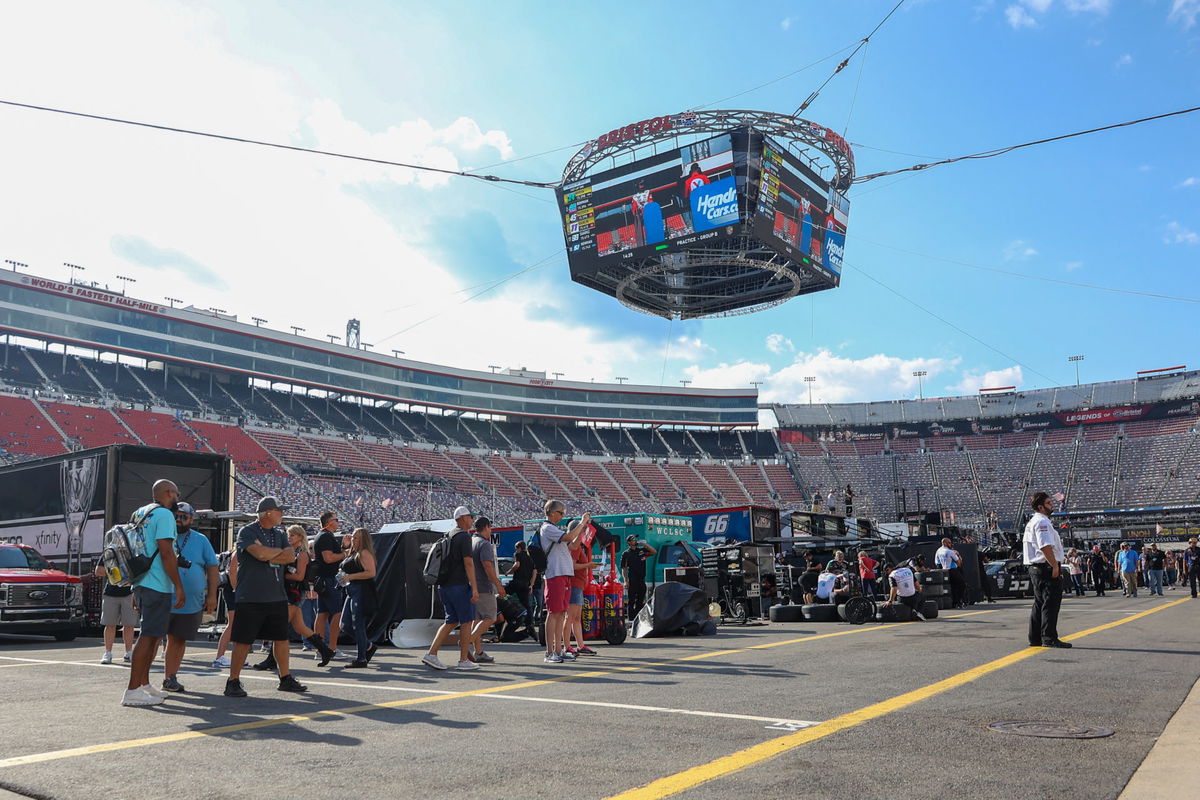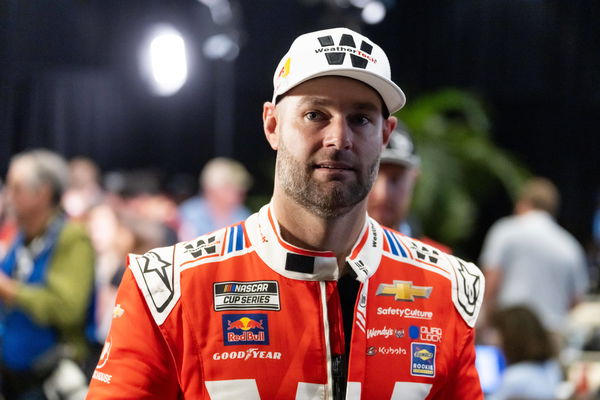
USA Today via Reuters
Sep 15, 2023; Bristol, Tennessee, USA; NASCAR fans watch from the pits during practice for the Bass Pro Shops Night Race at Bristol Motor Speedway. Mandatory Credit: Randy Sartin-USA TODAY Sports

USA Today via Reuters
Sep 15, 2023; Bristol, Tennessee, USA; NASCAR fans watch from the pits during practice for the Bass Pro Shops Night Race at Bristol Motor Speedway. Mandatory Credit: Randy Sartin-USA TODAY Sports
When NASCAR rolled out its bold new idea of an in-season challenge for 2025, there was real excitement at the top. Brian Herbst, NASCAR’s SVP of Media & Production, spoke about it with a spark in his voice. “There was TNT that was realizing early success with the NBA in the season tournament. And we just really liked the idea. We liked the idea of this bracket-style challenge,” he said, pointing to its NBA roots. NASCAR wasn’t just changing a rule; it was trying to rewire part of the season.
Watch What’s Trending Now!
The In-Season Challenge, as it was branded, promised head-to-head matchups, a $1 million payday, and a new twist in the Cup Series calendar. Herbst said the hope was to “drive storylines” and hook a younger fan base. He called it a “ramp-up” before the postseason, something that would generate excitement when things usually cooled off. NASCAR was banking on a format that brought March Madness energy to the track. Five races. One winner. Brackets, battles, and bragging rights.
From the outside, it looked fresh. And with streaming platforms eager for content, it made sense on paper. Despite the big promises and million-dollar hype, the excitement hasn’t trickled down to the fans. As the tournament’s start date nears, reactions online are lukewarm at best. Many fans are confused, and some are downright dismissive. NASCAR wanted a hit, but the crowd isn’t cheering yet.
ADVERTISEMENT
The NASCAR In-Season Challenge is a five-race knockout tournament. It features the top 32 drivers in the standings after Nashville. These drivers were seeded using their best finishes across the Michigan, Mexico City, and Pocono races. Once seeded, they enter a head-to-head bracket. In each round, drivers simply need to finish ahead of their matchup opponent to move on. Each race cuts the field in half, 32 to 16, then 8, 4, and finally the top 2 at Indianapolis.
Notably, the million-dollar prize will be claimed at the Brickyard 400 on July 27. However, the seeding process itself has caused confusion. Drivers are ranked based on their best finish in the three seeding races. If there’s a tie, the second-best finish is used. If needed, the third-best and then regular-season points come into play. Sounds simple, but in execution, it’s been hard to follow. With Shane van Gisbergen winning in Mexico but ineligible due to his 33rd-place standing after Nashville, fans questioned the clarity of the format. If a race winner can’t enter, how meaningful is the result?
One fan summed up the mood with a take on Reddit: “The way they are seeding it has me completely out. Three races to seed instead of the whole season so far?” It’s a valid point. Many drivers showing consistency all year don’t get rewarded. Others luck out with a single high finish. And while Shane van Gisbergen’s surprise win in Mexico was dramatic, it didn’t impact the Challenge since he was ineligible. That’s hard to explain to casual fans, and frustrating to loyal ones. Still, not everyone is disappointed.
ADVERTISEMENT

Imago
NASCAR, Motorsport, USA Daytona 500 – Media Day Feb 12, 2025 Daytona Beach, Florida, USA NASCAR Cup Series driver Shane Van Gisbergen during Daytona 500 media day at Daytona International Speedway. Daytona Beach Daytona International Speedway Florida USA, EDITORIAL USE ONLY PUBLICATIONxINxGERxSUIxAUTxONLY Copyright: xMarkxJ.xRebilasx 20250214_mjr_su5_020
Earlier this month, Denny Hamlin, who won at Michigan, the first seeding race, embraced the tournament. “If we go to a road course, suddenly, I’m telling you. I’m gonna tell Gayle, ‘Beat that guy’. I just want to beat that guy. Where we think, ‘Oh well, maybe we’ll stay out and get 3 stage points here.’ Hell no. I want to do whatever I have to do to beat that guy. So, we’re gonna care,” he said on his Action Detrimental podcast. He sees the head-to-head concept as a way to create personal rivalries and enhance competition.
ADVERTISEMENT
Hamlin isn’t just excited; he’s already emerging as a favourite. His Michigan win and his eligibility keep him atop the seeding chart despite missing Mexico to be with family. He’s currently lined up to face Carson Hocevar, the 32nd seed. “I think Hocevar has top-six talent,” Hamlin had said. That matchup, future Hall of Famer vs rising star, might actually deliver some spark to the bracket. If more drivers adopt Hamlin’s mentality, the Challenge might still catch fire.
Following the Mexico City race, Shane van Gisbergen’s win made headlines but didn’t move the Challenge bracket. That’s because he sat 33rd in points after Nashville and missed the 32-driver cutoff. Meanwhile, Chris Buescher climbed to the No. 2 seed with finishes of 2nd and 11th in the seeding races. Christopher Bell sits at No. 3, just ahead of Ty Gibbs. Chase Elliott fell just short of a top-four seed, losing the tiebreaker.
Meanwhile, Kyle Busch, once looking strong, dropped from 8th to 14th after crashing out early in Mexico. Alex Bowman jumped from 36th to 7th with a fourth-place finish. These swings show how volatile the bracket is and why many fans are struggling to keep track. Some drivers are in and out of the top 16 with each race, but few understand how or why it happens. However, as the tournament gets closer, the field is set, but the buzz is not. The $1 million prize sounds great, but excitement hasn’t followed.
ADVERTISEMENT
Fans sound off on NASCAR’s in-season challenge!
NASCAR’s new idea sounded bold, but the fans aren’t sold. Across social media and message boards, the reaction is mostly cold. One fan wrote, “No, at best it might be mildly interesting in the final race of the tournament.” That sentiment captures the general mood. Another said, “I haven’t heard a single thing about it. Almost forgot about it.” Even among loyal fans, awareness is low, and enthusiasm is lower. For a sport trying to capture attention, that’s a red flag.
Some appreciate the effort but still don’t feel invested. “No, but I like that they are continuing to think outside the box. Having some sort of hook is key with the younger generation,” one user noted. There’s respect for innovation, but execution matters more. And right now, the In-Season Challenge isn’t delivering. The three-race seeding window is too narrow. Drivers with great seasons could get a bad seed or miss the bracket entirely. That makes it harder for fans to follow or care.
ADVERTISEMENT
Another user pointed out, “I think it’ll be a lot more interesting after Pocono since TNT will advertise it heavily before NBC/USA takes over. Right now? Nobody really cares as it sits in the background.” The biggest problem is clarity. Brackets are exciting when they’re easy to track. But with changing rules, missing winners, and strange matchups, fans are left confused. Even the $1 million prize can’t hide the issues. In a sport built on energy and emotion, this idea hasn’t hit the mark.
The placement of the In-Season challenge also seems off; it doesn’t allow the winners to be a part of it. We have mid-pack drivers getting a shot at $1 million, but those winning after Nashville. Also, this might force some drivers to go all out for the cash price and thus potentially downplay the importance of the playoff seat. And things could go sideways in the hunt for the cash prize over the checkered flag. “I just heard about it today. Seems dumb—drivers are already trying to win every week, so what’s the motivation? Hopefully, the money doesn’t lead the drivers to do stupid things,” a race fan opined.
It will be interesting to see if this new change spices things up or gets junked like a failed experiment.
ADVERTISEMENT
ADVERTISEMENT
ADVERTISEMENT

